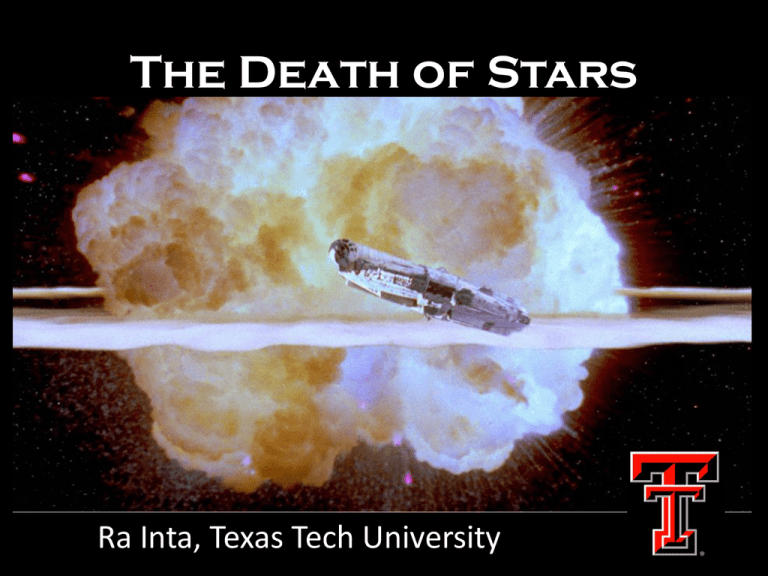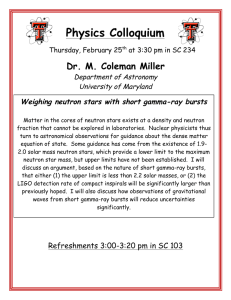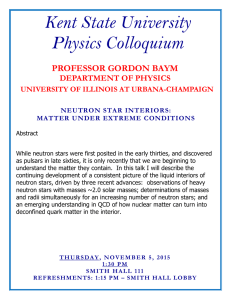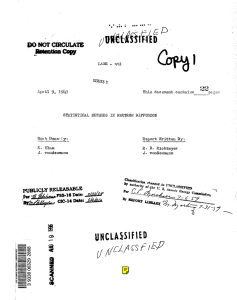The Death of Stars Ra Inta, Texas Tech University
advertisement

The Death of Stars Ra Inta, Texas Tech University I: Stellar Evolution ESO - https://www.eso.org/public/images/eso0728c/ Burning stages of a 25 M⊙ star Fuel Product(s) H He He C, O C Ne, Na, Mg, Al Ne O, Mg Duration 100 Myr 1 Myr 1000 yr 3 yr O Si, S, Ar, Ca 180 days Si Ni 1-5 days Triple-alpha process ‘Onion skin’ fusion layers Nucleon binding energies Electron degeneracy pressure: Chandrasekhar limit • Pauli Exclusion Principle – e- are fermions • Form Fermi-Dirac gas • Solve hydrostatic equation M Chandra 3 2 0 3 c G 3 2 1 e mH 2 ~ 1.39 M Sun Core collapse Ott C,. et al. ApJ 768(2) 115, (2013) II: Supernovae •Electron degeneracy pressure can’t keep Fe core from collapsing (core-collapse supernova) •Neutron formation is energetically preferred (ecapture) •Massive neutrino flux •Huge gravitational potential energy released: ~1046 J II: Supernovae https://upload.wikimedia.org/wikipedia/commons/1/14/Supernovae_as_initial_mass -metallicity.svg III: Supernova remnants • Some supernovae leave behind material (gas and/or dust) expelled from supernova • Three expansion phases: 1. Free expansion (up to few hundred yr) 2. Adiabatic expansion (kyr) 3. ‘Snow-plow’ (Myr) Famous supernova remnants (SNRs) SN1987A ALMA (ESO/NAOJ/NRAO)/A. Angelich. Visible: Hubble Space Telescope X-Ray: Chandra •Closest SN in 400 yr •Enabled observation of radionucleides •Neutrinos detected •Blue supergiant progenitor SN 1054: the Crab Nebula •Best known SNR •Seen by Chinese and Arab astronomers •Most luminous nebula •Most luminous pulsar Casseiopeia A •Young (300 yr) •One of first radio sources •Brightest radio source (>1GHz) •Carbon atmosphere Sedov-Taylor expansion r t E C 2 5 Vela Jr. •Only seen in x-ray or higher •Possibly only 200pc away •Possibly only 780 yr old (τ½( 44Ti ) = 60 yr ) The cosmic ray mystery • Ice cores • 60Fe in the sea floor • Periodic global ice ages/warming • Tree rings? IV: Neutron Stars Tolman-Oppenheimer-Volkoff limit (neutron degenerate analogy to Chandrasekhar limit) M TOV ~ 1.5 3.0 M Sun •Assume neutrons form degenerate cold Fermi gas •Strong nuclear force much shorter range •Equation of state highly uncertain •We’ve observed ~2M⊙ neutron stars Neutron degeneracy • Exclusion principle • Degenerate electrons • Inverse beta decay (creates neutron ‘soup’) Properties of neutron star (NS) • • • • Hot (but ‘cold’) Huge magnetic fields Strongest material known Exotic core? Material properties of NS crust (BCC phase): • Pre-2008: Extrapolation from Terrestrial metals [Smoluchowski, R.: "Frequency of Pulsar Starquakes," Phys. Rev. Lett. 24, pp.923-925 (1970)] • Post-2008: Modelling of crust as a ‘Coulomb solid’ gives 10X shear strength [Horowitz, C.J. and Kadau, K.: "Breaking Strain of Neutron Star Crust and Gravitational Waves," PRL 102, 191102 (2009)] FGravity > FCoulomb, and electron degeneracy So local defects not supported! Magnetic field Field strengths ~ 104 – 1011 T (Earth: ~ 30μT) V: Persistent Gravitational Waves • Gravitational waves: travelling perturbations in space-time • Produced by (non-axisymmetric) acceleration of mass/energy • Perturbation seen as a strain (δL/L) • Tiny amplitudes: 2G hij 4 I ij c D Triaxial model • Rotating, non-axisymmetric neutron stars (and possibly axions...) • Low h0(t) ... but can average Divergence from axisymmetry: ellipticity max. max. ~ 5 10 -1 10 I xx I yy -6 I zz Determines maximum height of ‘hills’ supported within NS crust ( O(few mm) ) Expected strain amplitude: 4 G I zz f h0 4 c D 2 2 GW Cassiopeia A •Young (~300 yr) compact object •Position is well known Neutron star •Unknown spin-down parameters Wette, K. et al.: "Searching for gravitational waves from Cassiopeia A with LIGO," Class. Quantum Grav., 25(235011):1-8 (2008) Manifold parameters for Cas A Assumptions: • f0 in LIGO band (~10% of pulsars) • Braking index, n = 5 → quadrupole radiation (but n f·f n 2 f Cas A very young → second spin-down required Spin - down parameters : f, f and f Manifold parameters : λ1 f 0 , λ2 f, λ3 f obs.~ 3 ...) Age-based Upper Limit hage 5GI zz 3.4 kpc I zz 300 yr 24 1.2 10 3 38 2 8c D 10 kg m How GWs are detected Credit: Shane Larson, Northwestern University The LIGO Network 4 km baseline, seismic isolation The LIGO-Virgo Network Computational bound All this averaging means CW searches are computationally limited Cas A search took 420,000 CPU hrs on Albert Einstein Institute’s Atlas supercomputer We used this bound explicitly to determine a figure of merit for other targets What targets we look at Aasi, J. et al.: “Searches for Continuous Gravitational Waves from Nine Young Supernova Remnants,” ApJ 813 (1) 39, 16 pp. (2015) Young compact objects in SNRs SNR (G name) RA+dec (J2000) D (kpc) τ (kyr) 1.9+0.3 174846.9-271016 8.5 0.1 18.9-1.1 182913.1-125113 2 4.4 Other name 93.3+6.9 DA 530 205214.0+551722 1.7 5 111.7-2.1 Cas A 232327.9+584842 3.3 0.3 189.1+3.0 IC 443 061705.3+222127 1.5 3 266.2-1.2 Vela Jr. (I) 085201.4-461753 0.2 0.69 266.2-1.2 Vela Jr. (II) 085201.4-461753 0.75 4.3 291.0-0.1 MSH 11-62 111148.6-603926 3.5 1.2 347.3-0.5 171328.3-394953 0.9 1.6 350.1-0.3 172054.5-372652 4.5 0.6 Upper limit plots








